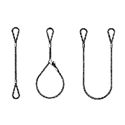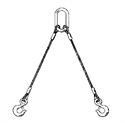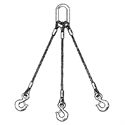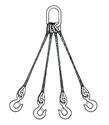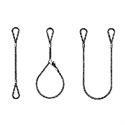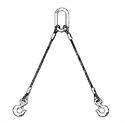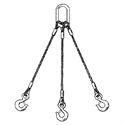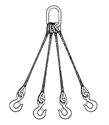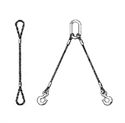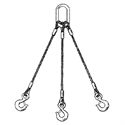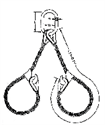Wire Rope Slings
- 1
- 2
Single Leg Wire Rope Slings 6x19 & 6x37 Bright - EIPS IWRC
Double Leg Wire Rope Slings - 6x19 & 6x37 Bright EIPS IWRC
Triple Leg Wire Rope Slings - 6x19 & 6x37 Bright EIPS IWRC
Quad Leg Wire Rope Slings - 6x19 & 6x37 Bright EIPS IWRC
Single Leg Wire Rope Slings - Stainless Steel Type 302 & 304 IWRC
Double Leg Wire Rope Slings - Stainless Steel Type 302 & 304 IWRC
Triple Leg Wire Rope Slings - Stainless Steel Type 302 & 304 IWRC
Quad Leg Wire Rope Slings - Stainless Steel Type 302 & 304 IWRC
Single & Double Leg Wire Rope Slings - Cable Laid (7x7x7 & 7x7x19)
Triple Leg Wire Rope Slings - Cable Laid (7x7x7 & 7x7x19)
8-Part Braid - Double Leg Choker Wire Rope Slings
8-Part Braid - Double Leg Wire Rope Slings
- 1
- 2
Wire rope slings are a basic material handling tool and are the most frequently used type of sling in industry today. They offer strong, dependable and economical option for most lifting applications. Their popularity is enhanced by the numerous sling configurations available to support a broad range of applications. These configurations include single and muti-part slings (such as round braids, flat braids, & cable laid slings), grommets, single leg slings, multiple leg bridles, and a wide variety of fittings and attachments. Some of our most popular wire rope assembies are guys lines, tong snub lines, winch lines, mast raising lines, BOP slings, geronimo lines, and air hoist lines to name a few. We also specialize in complete rig packages including any fall protection requirements.
The wire rope sling is not quite as durable as an alloy chain sling. It is not as flexible as alloy chain slings but its greater stiffness can be an advantage if it has to be inserted through a small opening or beneath a load. However, when wrapped around a load, it often tends to deform permanently to the shape of the load. Wire rope suitable for slings comes in a variety of grades and constructions. Wire rope slings are generally less expensive and lighter than alloy chain slings which can be a benefit, particularly for applications that requrie long lengths.
A mechanical (or flemish) splice sling is most frequently used and is fabricated by unlaying the rope body into 2 parts, one having 3 strands, the other having the remaining 3 strands and core. The rope is unlayed far enough back to allow the eye to be formed by looping one part in one direction and the other part in the opposite direction and laying the rope back togehter.
The strands are rolled back around the rope body and a carbon steel sleeve is slipped over the ends and swaged (or pressed) to secure the ends to the sling body. A hydraulic swaging press with special dies is used to bond the sleeve in place. Extreme pressure forces the steel sleeve to flow into the voids between the wires and strands, creating an assembly that maintians most of the wire ropes nominal breaking strength. Once complete the sleeve is painted to complete the fabrication process.
Single, double, triple and quad leg slings can be designed and fabricated within close tolerances to desired specifications. For saftey purposes, it is essential that all fittings and attachments carry a rated capacity equal to or greater than that of the wire rope sling. In cases where this is not possible, the rated capacity of the entire assembly must be downgraded to the weakest component. In addition to the basic slings described above cable laid slings or 8-part braids may be selected for their distinctive characteristics.
Mobile Load Testing Services & Inspections
We offer inspections and mobile proof test services for product verification, break testing, and load testing to ensure compliance for all wire rope slings we sell and repair. Our mobile proof test services are available throughout the United States. In addition to our mobile load testing services we have stationary test beds to service Oklahoma, Texas, Kansas, Wyoming, North Dakota, New Mexico and all surrounding areas. Feel free to contact one of our industry professionals today at 866-369-9507.


